

|
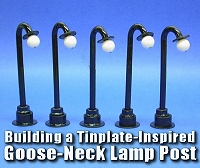 Note from Editor: Since Howard and I have been putting together the Tribute to Tinplate(tm) series, we have realized that authentic-looking period accessories help "cinch" the overall look of the tinplate era. This "goose-neck lamp post" doesn't actually light but, like the straight-up-and-down lamp posts Howard developed to go wtih the "Lewis Park" tinplate station project, it brings back a whole era. And like most of our other Big Indoor Trains(tm) projects, it costs almost nothing to put together. Note from Editor: Since Howard and I have been putting together the Tribute to Tinplate(tm) series, we have realized that authentic-looking period accessories help "cinch" the overall look of the tinplate era. This "goose-neck lamp post" doesn't actually light but, like the straight-up-and-down lamp posts Howard developed to go wtih the "Lewis Park" tinplate station project, it brings back a whole era. And like most of our other Big Indoor Trains(tm) projects, it costs almost nothing to put together.
Building a Tinplate-Inspired Goose-Neck Lamp Post
After I made some of the little straight-up-and-down lamp-posts to go with the 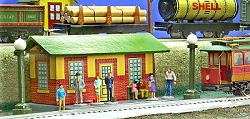 "Lewis Park" tinplate station project, I thought about modeling another popular lamp-post from the tinplate era. I retained the "given" that the lamp post wouldn't actually light, which freed me to cast about for free or very cheap materials. One day I realized that those cheap plastic hangars have two very suitable curves for such a project. Again, once I had done one, I couldn't help but put together a whole street's worth of them. "Lewis Park" tinplate station project, I thought about modeling another popular lamp-post from the tinplate era. I retained the "given" that the lamp post wouldn't actually light, which freed me to cast about for free or very cheap materials. One day I realized that those cheap plastic hangars have two very suitable curves for such a project. Again, once I had done one, I couldn't help but put together a whole street's worth of them.
Materials Needed:
The following list contains suggestions only - you may have something onhand already that suits your purposes better.
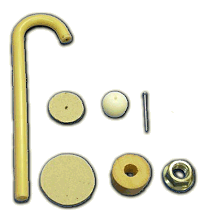 A cheap plastic coat-hanger, the kind you get ten for a dollar at the "Dollar Store." In the photo to the right, you can see that I have already "sliced and diced it." A cheap plastic coat-hanger, the kind you get ten for a dollar at the "Dollar Store." In the photo to the right, you can see that I have already "sliced and diced it."
- A white glue
- Black acrylic paint
- A craft brush
- A flanged nut just big enough to fit over the hanger material. I used a 3/8" nut with a "built-in-washer."
- Something for the "fat" part of the stand. For my "O-gauge tinplate" version I used a broom-stick handle that I sliced into short lengths. Or you could use the "plug" from a hole saw, with a little sanding.
- A can of glossy clear acrylic finish (indoor-outdoor is best)
- A plastic white or "pearl" bead from toy jewelry
- One straight pin
- For the "flange" base, I built up a couple of layers of thick, noncorrugated cardboard like you get from the back of a writing tablet. A small square or circle of Masonite-type material or thin plywood would work as well.
Chances are you have most, but not all of the things you need right now - if you take a little time to think, you can probably scrounge something that will replace the other supplies without leaving the house.
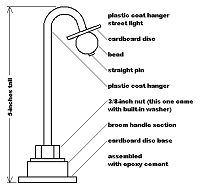 Downloading the Plan Downloading the Plan
The plan for this task is really just to show you one way to put the pieces together. How your final project looks, or what size it is really depends on what materials you wind up using, and your personal preferences. But if you want to download the plan to get one example, simply click on the graphic to the right.
Assembling the Lamp Post
The steps you take in final assembly of the base will depend on what materials you selected.
- Predrill the base. Drill a hole in the "fat part" of the base that is just big enough to accept the hanger material.
 Predrill the post tip. Although some of these hangers actually have a hollow place or "air bubble" at the center, you will probably need to pre-drill a hole in the curved end of the hanger piece for the straight pin to go into. It's possible to do that a speed drill and the smallest diameter nail you can find. Try not to drill so deep or wide that the straight pin wobbles when you insert it, though. Predrill the post tip. Although some of these hangers actually have a hollow place or "air bubble" at the center, you will probably need to pre-drill a hole in the curved end of the hanger piece for the straight pin to go into. It's possible to do that a speed drill and the smallest diameter nail you can find. Try not to drill so deep or wide that the straight pin wobbles when you insert it, though.
- Glue the post together, except for the bead. Keep an eye on it while it's drying to make sure nothing slips out of place.
- When that glue is very dry (overnight is best) paint the post all over. Black or dark green are the most typical colors for this sort of lamp. Lionel sometimes used silver as well.
When paint is dry, give the lamp post several light coats of the clear, glossy acrylic finish. Give time between coats to dry to touch, so you don't get drips or streaks.
- Stick the bead and straight pin on and glue in place.
Conclusion
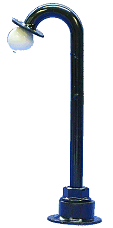 Of course once you make one of these and set it on your railroad, you might feel the need to make another five or six. We are definitely interested in seeing how these projects look on your railroad or display village. Please contact
us for information about how to send digital photos. Of course once you make one of these and set it on your railroad, you might feel the need to make another five or six. We are definitely interested in seeing how these projects look on your railroad or display village. Please contact
us for information about how to send digital photos.
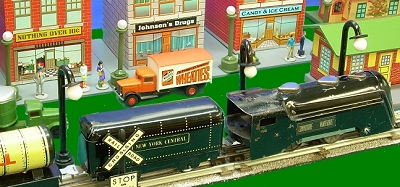 If you like this project, stay in touch - more "Tribute to Tinplate(tm)" projects are on the way. In the meantime, you might like to take a look at the following projects.
If you like this project, stay in touch - more "Tribute to Tinplate(tm)" projects are on the way. In the meantime, you might like to take a look at the following projects.
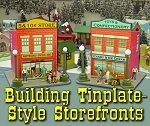 Building TinPlate-Syle Store Fronts -
Expanding our Tribute to Tinplate(tm) community is a set of down-town-style store fronts inspired by a series of tinplate candy containers that were made in the early -to-mid 1900s by West Brothers. The original containers were pretty small, but we've redrawn the graphics in larger scales and added a bit of additional detail so they'll fit into any tinplate or faux-tinplate setting. Building TinPlate-Syle Store Fronts -
Expanding our Tribute to Tinplate(tm) community is a set of down-town-style store fronts inspired by a series of tinplate candy containers that were made in the early -to-mid 1900s by West Brothers. The original containers were pretty small, but we've redrawn the graphics in larger scales and added a bit of additional detail so they'll fit into any tinplate or faux-tinplate setting.
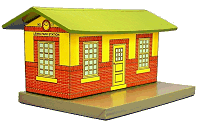 Building a Vintage "Lithographed" Station" - the first article in our "Tribute to Tinplate" series, based on a prewar American Flyer standard-gauge station. Includes free, downloadable graphics, plans, and instructions for modeling in O/S and Large Scale/Standard Gauge. Building a Vintage "Lithographed" Station" - the first article in our "Tribute to Tinplate" series, based on a prewar American Flyer standard-gauge station. Includes free, downloadable graphics, plans, and instructions for modeling in O/S and Large Scale/Standard Gauge.
- Building a Vintage Tin-Style Cottage
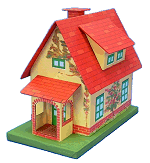 - This project is inspired by a popular pre-war tinplate house that was made to go with standard gauge trains, like the early 1900s-era Ives and Lionel. Paul Race's commercial-quality graphics, as well as Howard Lamey's plans and assembly details are all free, to give your railroad a vintage tinplate look with a few cents' worth of materials. Many options are available, and most graphics and plans can be downloaded directly from the article. - This project is inspired by a popular pre-war tinplate house that was made to go with standard gauge trains, like the early 1900s-era Ives and Lionel. Paul Race's commercial-quality graphics, as well as Howard Lamey's plans and assembly details are all free, to give your railroad a vintage tinplate look with a few cents' worth of materials. Many options are available, and most graphics and plans can be downloaded directly from the article.
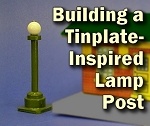 New
Feature - Building a Tinplate-Inspired Lamp Post The ideal accessory for the Lewis Park Station, or any station or city hall on your railroad or holiday village. No, they don't actually light, but they are cheap and easy to build and add a great deal of vintage interest to any setting. Free downloadable plans are available in several scales. New
Feature - Building a Tinplate-Inspired Lamp Post The ideal accessory for the Lewis Park Station, or any station or city hall on your railroad or holiday village. No, they don't actually light, but they are cheap and easy to build and add a great deal of vintage interest to any setting. Free downloadable plans are available in several scales.
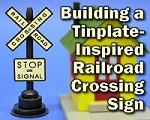 New
Feature - Building a Tinplate-Inspired Railroad Crossing Sign This is the ideal accessory for the Watchman's Shanty project. Based on a series of products that are now available only as expensive collector's items, this easy and almost-free project will add texture, interest, and period to any model railroad or holiday village. New
Feature - Building a Tinplate-Inspired Railroad Crossing Sign This is the ideal accessory for the Watchman's Shanty project. Based on a series of products that are now available only as expensive collector's items, this easy and almost-free project will add texture, interest, and period to any model railroad or holiday village.
- Easy Street Scene - This new
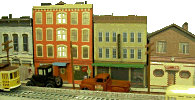 building project uses downloadable building graphics and a little cardboard or foam board to build up a convincing downtown scene that is only a few inches deep - perfect for shelf layouts, tight spots, and dioramas. We also provide links to high-resolution graphics that will work for any scale. building project uses downloadable building graphics and a little cardboard or foam board to build up a convincing downtown scene that is only a few inches deep - perfect for shelf layouts, tight spots, and dioramas. We also provide links to high-resolution graphics that will work for any scale.

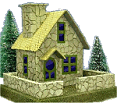 Build a Vintage-Style Cardboard Stone Cottage - This building project is made like the vintage cardboard houses folks used to set around their Christmas tree in the early 1900s (before glitterhouses became common), but its design was inspired by a building that shows up on the "Isle of Sodor." The building uses free downloadable graphic paper to put a realistic stone veneer on an old-world cottage and fence. It works with Christmas villages, or with a little customization, would dress up any indoor railroad. A "brick cottage" option is also shown.
Build a Vintage-Style Cardboard Stone Cottage - This building project is made like the vintage cardboard houses folks used to set around their Christmas tree in the early 1900s (before glitterhouses became common), but its design was inspired by a building that shows up on the "Isle of Sodor." The building uses free downloadable graphic paper to put a realistic stone veneer on an old-world cottage and fence. It works with Christmas villages, or with a little customization, would dress up any indoor railroad. A "brick cottage" option is also shown.
 Log Cabin Building Flat - This "building flat" uses downloadable graphics and foam board or cardboard to dress up a narrow corner of your railroad or village. The techniques in this project can be used for almost any kind of building you want to represent in a tiny space. December, 2007 Log Cabin Building Flat - This "building flat" uses downloadable graphics and foam board or cardboard to dress up a narrow corner of your railroad or village. The techniques in this project can be used for almost any kind of building you want to represent in a tiny space. December, 2007
- Build a Vintage-Style Barn and Silo - This
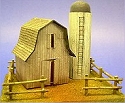 building project uses downloadable graphics to put realistic shingles and siding on an old barn and silo. Like the stone cottage above, it works with Christmas villages, or with a few changes, it would dress up an indoor railroad. building project uses downloadable graphics to put realistic shingles and siding on an old barn and silo. Like the stone cottage above, it works with Christmas villages, or with a few changes, it would dress up an indoor railroad.
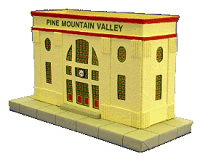 Building the Union Station - This original project by designer Howard Lamey is inspired by two traditions - the cardboard Christmas houses that were popular in US homes between 1928 and 1965 and the Lionel station that was popular for most of the 20th century. Building the Union Station - This original project by designer Howard Lamey is inspired by two traditions - the cardboard Christmas houses that were popular in US homes between 1928 and 1965 and the Lionel station that was popular for most of the 20th century.
Other Articles about cardboard houses include:
|

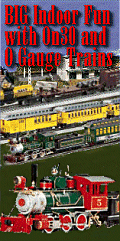

|





 "Lewis Park" tinplate station
"Lewis Park" tinplate station




 Building TinPlate-Syle Store Fronts
Building TinPlate-Syle Store Fronts Building a Vintage "Lithographed" Station"
Building a Vintage "Lithographed" Station"
 New
Feature - Building a Tinplate-Inspired Lamp Post
New
Feature - Building a Tinplate-Inspired Lamp Post New
Feature - Building a Tinplate-Inspired Railroad Crossing Sign
New
Feature - Building a Tinplate-Inspired Railroad Crossing Sign




 Building the Union Station
Building the Union Station 



